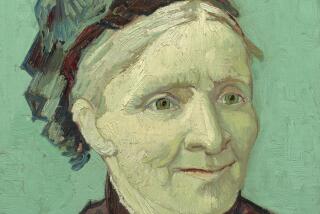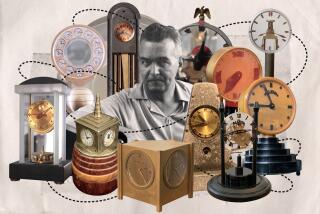Time of Her Life
- Share via
Time in the 18th century library: 9:55.
Real time: 9:56 a.m.
*
Jacqueline Dugas unhooks the velvet rope and tiptoes around the Louis XIV carpet to Philibert Pont St. Michel. Philibert’s lilting voice floats through the Huntington Art Gallery in San Marino--the same voice that told time in Napoleon’s day. Marble, bronze and gilt, flanked by the perfection of two Sevres mantle vases, the clock has a haughty, regal air. It would surely loathe the fact that it strikes the hour a minute late.
But here is Dugas to set Philibert right, with the turn of an antique key. Twice a week, Dugas winds the gallery’s 16 antique clocks. Sometimes, she comes in on her days off to wind the clocks. She schedules vacations around them. Just so people can feel the pulse of the 18th and 19th centuries in their movement.
She worries that Guydamour runs fast, that Grandfather is cranky, that the Cronier gets overlooked because it has the misfortune of sitting under a Rembrandt. She is anxious about their health and strokes their cases only with her fingertips. With a few clocks, she holds her breath until she lifts their plexiglass cases and hears their heartbeats. Then she goes back to work.
Dugas’ job at the Huntington has nothing to do with clocks.
On most days, she handles mountains of paperwork on a roll-top desk in a busy reception area. As the museum’s registrar, she tracks each piece of art in the collection. She will record the movement of an 18th century Wedgwood tureen from one case to another or fax the humidity reading of a room to Windsor Castle curators who want to check on a loaned exhibition.
Dugas, who is in her 40s, sometimes throws back her head for effect, tossing the red hair that tumbles past her shoulders onto a dress or suit jacket. Her speech is warm and musical, her sentences full of parentheses and exclamation points. She doesn’t wear her watch because it feels clunky around her wrist.
Walking through the nine rooms that house the clocks, she pursues lengthy asides on French ribbon and Andrew Lloyd Webber. No clock story is too small to recount: On this clock, the cupid used to hold an arrow! And no misbehaving clock ever gets more than a soft reprimand from her: Now, sweetie. . . .
“The clocks make the galleries come alive,” she says. “I just think they add to the spirit and soul of the place.”
*
Every time Dugas winds a clock at the Huntington, she is taking sides in a fierce but arcane debate. Among horologists--the scholarly term for clock experts--the world is deeply divided between those who believe in winding or not winding.
Dugas is no horologist. Horologists turn grave, not gooey, when talk turns to ticking clocks.
It is important to preserve the original guts of a clock and to avoid the strain of motion, says Gillian Wilson, curator of decorative arts at the J. Paul Getty Museum. You put an antique clock at risk by keeping it oiled and running. What if dust sticks to the oil and gunks up the gears? What if a pendulum snaps off a silk thread?
No, no, no. The clocks were made to run and will waste away if they don’t, insists horologist Thomas Bartels, executive director of the National Assn. of Watch and Clock Collectors in Columbia, Pa.
Hearst Castle does not wind its two antique clocks, which are kept in plexiglass cases.
But at Mount Vernon, the mantle clock still runs in the bedroom where George Washington died in 1799.
The J. Paul Getty Museum, on the other hand, does not run its 21 antique clocks.
At the American Clock & Watch Museum, about 50 of 1,500 display clocks keep time. Small children, the curators say, sometimes wonder how a clock runs without a battery or electricity.
At the Huntington, most of the clocks sit on mantles or French tables--and they have always ticked. They give the place a homey feel, says Shelley Bennett, the museum’s curator of British and Continental art.
In the Huntington Art Gallery one afternoon, Roy Wood, 72, stops in front of an English clock from the early 1800s. Wood, of West Covina, wears shorts and tennis shoes, and a camera dangles around his neck.
He looks at the clock; he looks at his watch. The antique clock says 2:45; his Seiko digital says 2:46. He cannot believe it.
“I think,” he says, “they slipped some quartz in the back.”
*
Time in the 18th century sitting room: 4:35.
Real time: 4:30 p.m.
At first, Dugas was scared to touch the clocks. Clocks signed horloger du roi, or clockmaker to the king; rococo clocks with delicate leaves and tendrils and marble; a clock believed to be from the collection of Marie Antoinette.
Even though she received her bachelor and master’s degrees in art history from UC Santa Barbara, she had no training in antique clocks. In fact, she had no particular love for the Huntington’s clocks when, eight years ago, she asked to take over the task of winding them from a departing exhibits preparator. She saw it as a way to get into the gallery, the way she used to do as a kid.
Growing up in San Marino, a few blocks away from the Huntington, Dugas would ride her bike to the 207-acre grounds every few weeks. She used to lose herself in the life-size English portraits of “The Blue Boy” and other paintings in the gallery, the former home of railroad magnate Henry E. Huntington. The gallery and the botanical gardens were her playground. So when a job at the Huntington came open, she jumped.
Even now, after 13 years on the Huntington’s staff, she walks through the gallery with wonder. “The old house,” she half-whispers, “isn’t it grand?”
By now she knows the feel of all the clocks. She knows that the clock signed Guydamour needs only a few winds and that the Vulliamy takes more than 20. She frets when one rings in late.
She is anxious about the tall clock. His heartbeat is loud but a little uneven. “Poor Grandfather,” she says. He’s 200 years old and runs a little slow. “That old guy, he can’t help it.” But what a glorious, full-bodied voice! Like a streetcar’s clang! She can hear him anywhere in the gallery.
She cleans the clocks with a soft brush or cloth. When adjusting their time, she tries not to stress the clocks by forcing their hands backward. In the fall, for the time change, she moves the hands forward 11 hours.
The clock-winding keys used to be thrown into a worn cardboard box. She hated that. So she brought in a gilt decoupage box from home and makes her rounds with a pocket-size digital clock to check the time.
Uh oh. The Three Graces clock does not chime on the half-hour.
“C’mon, honey!” Dugas urges.
Finally. The Three Graces rings in at 35 minutes past, last in the chorus of chimes in the gallery.
Five minutes late. What will people think?
The Three Graces--young nudes of gilt bronze, draped with garlands of flowers--hoist a globe in their slender arms. A winged cherub sits atop the globe, which holds an 18th century clock signed by the famous maker Lepaute.
“Oh,” Dugas groans. “How can I fix this? It’s just being real bratty.”
Her tone turns sweet.
“And I usually don’t say that about you ladies, but I’m saying it now.”
Dugas frowns. But she doesn’t want to tinker with the insides and decides to leave the Three Graces for the Huntington’s outside clock expert, who does the repairs and major cleanings.
Alone in the gallery, Dugas gets to wondering about time and why there doesn’t seem to be any.
Why is it, she muses, that the old clocks run at the same pace they used to, but time whizzes by so much faster? Back then, no one cared much if the clocks were off a minute or two--who rushed?
And now? Now, she never gets to mending the silk brocade jacket that she bought at Rudolf Nureyev’s estate sale. Or to stumble through Rachmaninoff’s third piano concerto. Or to sit on her deck in Altadena for Scrabble or chess with her husband and college-age son.
“What’s the metaphor?” she says.
“You have to continue a thread of continuity--loving the collection--or you get buried in the stressful things . . . in a world of paperwork and deadlines and pressures.”
More to Read
The biggest entertainment stories
Get our big stories about Hollywood, film, television, music, arts, culture and more right in your inbox as soon as they publish.
You may occasionally receive promotional content from the Los Angeles Times.










